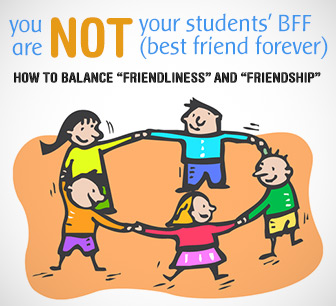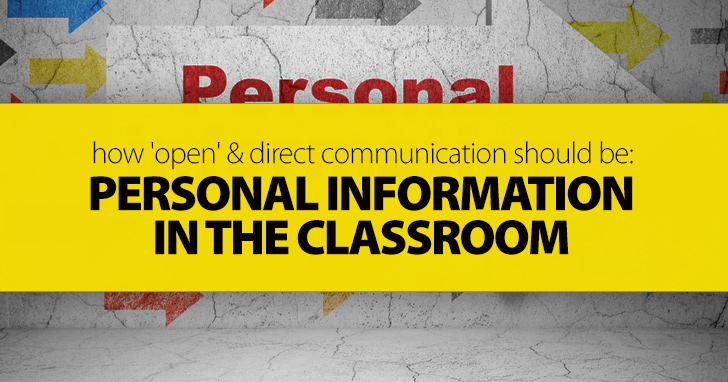You Are NOT Your Students’ BFF (Best Friend Forever): Balancing “Friendliness” and “Friendship”


“Openness” may also be in a backlash to traditional U.S. manners which tend to emphasize reserve. The cultural change in revealing one’s innermost secrets, which in the past would have been kept secret, can also be seen in popular culture, where celebrities as well as the lesser known readily reveal such information as abuse, addiction disorder, and mental health concerns. There is also the proliferation of “reality” TV, in which people invite cameras into their homes to film their family dysfunction for the public’s entertainment. Some of this change has actually been positive—individuals shouldn’t have to hide their heritage or sexual orientation, for example.
In addition, opinions on what is appropriate public information about oneself vary across cultures and generations. Therefore, in the classroom, especially the multicultural classroom, care should be taken on how much students should be expected to reveal about themselves even in a culture with an increasing expectation of self-revelation.However, there should also be boundaries in this openness--an opinion a number of people apparently share, as seen in the popular use of the acronym “TMI” or “too much information” (about one’s personal life).

Take into account cultural and personal boundaries. Many students are uncomfortable revealing so much about themselves. That boundary should be respected. When I was a new graduate student twenty years ago, just on the cusp of this movement of self-revelation, I had an instructor who twice pulled me into her office to complain about “distance” in my writing. I was already writing professionally at that time and was surprised by a serious complaint about my work. However, willing to correct any deficiencies, I asked her to please point out instances of what she was talking about. She didn’t but just reiterated the complaint. Because “distance” and objectivity is usually a value in academic writing and higher education in general, her concerns continued to elude me. I’ve since concluded that she was annoyed that I refused to participate into the kind of therapy session her class regularly devolved into—students and instructor sitting in a circle, and sooner rather than later abandoning discussion of the curriculum and moving into their personal lives. I was simply uncomfortable with this. Because instructors have an obligation to teach the students who come to their class and not pick and choose their culture or personality type, boundaries should be respected.
Another concern with self-revelation in the classroom is the loss of professional distance. If students are too self-revelatory, there is a breach of the boundary that exists between students and teachers that is there for a reason: students and teachers are in actuality not peers even with pretenses that they are. When there is an imbalance in power—instructors hold power over students in their grades and possibly entire academic future—the relationship is not equal. Therefore, some distance must be maintained. Students and teachers are really are not friends free to share everything without fear of repercussions.
Another related concern of the loss of professional distance when self-revelation goes too far is the introduction of bias into the grading process. Professor “Turner” did not like me because I didn’t participate in her group therapy nor did I treat the class journal as a personal diary. My grade reflected her frustration with this reserve. In a contrasting situation, a number of years later, when I was myself a college professor, I allowed a student to confide in me personal details related to an emotionally abusive relationship that were affecting her class grade. Later, when that grade was not up to her usual standards, she was angry because she had opened herself to me. It can be difficult to turn students away, or seem to, because teachers are usually compassionate individuals. However, to preserve the objectivity of the grading system, students with personal problems should be referred to professionals trained in addressing them.
A final and prime reason to avoid too much openness in the classroom is the potential creation of a hostile environment. The incident with Professor Turner and her group therapy sessions would not have occurred today because if not I then another student would have taken the situation to the dean regarding the creation of a hostile environment—that is, a learning situation that is so oppressive or anxiety-producing to individuals that learning becomes impossible. The students’ comfort level and safety in the learning process takes precedence over the individual instructor’s preferred teaching style.

A journal in an academic sense is not a personal diary. Because students often confuse the two—most have had experience with a diary but not a class journal—care must be taken to distinguish the two. The personal diary many students have kept reveals their reflections on their personal lives: indeed, the diary is often seen as so private that it is hidden away even from family members. An academic journal, on the other hand, is meant as reflections on course material and drawing connections between it and other material students have read and in turn to their professional and academic—not personal—lives. An academic journal, in addition, is intended for an audience, unlike the secrets of a diary. Make the distinction between the two clear and what is expected in an academic journal.
Many instructors start the semester assignment with a writing topic that will demand in response a personal narrative, an account of something important that happened to the student—in itself fine and a traditional way to start a writing class. Most of us have some experience telling stories about our own or other’s lives. The potential problem lies in the specific topics assigned: topics related to experiences of trauma and disagreements with family and friends, for example, invite the kind of intimacy that should be avoided to preserve professional distance and student comfort levels. More appropriate topics might relate to students’ introduction into the academic community, such as experiences related to coming to college and how it contrasts with high school. Assignments like these not only preserve comfort levels and objectivity but also lead to student reflections on the academic community they are entering.
A much-touted, perhaps too much so, strategy in recent years has been moving from the traditional classroom design of rows of desks where students sit facing the instructor, who stands in the front of the room and lectures. Replacing this is the circle of desks facing each other, the instructor joining as just another member of this group. There are several problems here, however. The first is it seems facile to claim the simple change in a seating arrangement has so many advantages: breaking down barriers, fostering classroom interaction, creating equality and so forth. In addition, even if these claims prove true, it is not a given that the changes are positive. As noted, the barriers are there for a reason, and since the student-teacher relationship is not equal to begin with, pretenses that it is are troubling.
There are advantages in the movement toward more self-disclosure in the classroom. If implemented well and without undue pressure, it can foster learning in allowing students to feel safe in being who they are and free to share ideas related to the class curriculum without fear of criticism. There are pitfalls, however, in crossing boundaries and creating a nonprofessional and even hostile environment. Therefore, a curriculum that invites student self-disclosure should be approached with care.